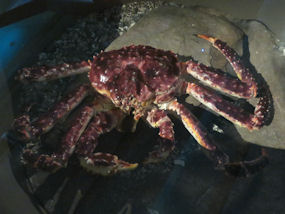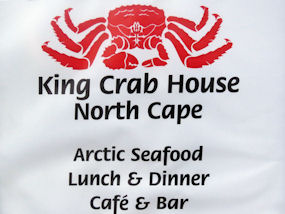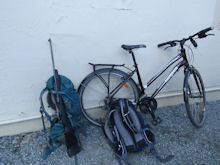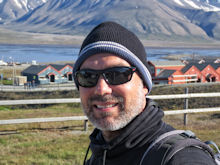Journey to the Arctic Ocean: In the kingdom of giant crabs, whales and polar bears
- Roger Blum

- 2. März 2022
- 6 Min. Lesezeit
Aktualisiert: 2. März
The Arctic is the fascinating landscape that lies beyond the Arctic Circle. It remains dark here for most of the year and the scenery is nearly always covered with ice and snow. But in summer, the area is continuously in range of the sun. The almost constant light means that you can go diving almost twenty-four hours a day and observe the area’s unique wildlife. Only at night diving excursions are not readily available. Or does a dive under the midnight sun count as a night dive?

Our ship crossed the Arctic Circle. The imaginary line that runs across the sea at 66° 33´ 51´´ separates the polar zone from the temperate latitudes. As it is a maritime tradition, Neptune appeared on board and we polar newcomers received our Artic baptism. After eating some local green slime and drinking an "algae cocktail" on the rocks, I received Neptune's blessing to continue my journey north.

Midnight sun is a natural phenomenon that occurs in the summer months in places north of the Arctic Circle
North Cape - A (non-existent) night dive in the land of the midnight sun
We reached Honningsvag, a small fishing village on the island of Mageröya at the extreme northern tip of Norway. Situated more than 500 km north of the Arctic Circle, the island has a barren and rugged beauty. From here it is only 34 km to the famed North Cape of Norway. The slate plateau is located at 71° 10´ 21´´ northern latitude and is considered to be the northernmost point of Europe.
Of course I paid the Cape a short visit. There was thick fog and rain. A decorative globe that has sits on the plateu of the North Cape was only vaguely visible. The famed sculpture marks the "End of the World" in the north. The fact that the northernmost point of Europe’s mainland is not even there, but 1.3 km further on the neighbouring Cape Knivskjelodden, doesn’t seem to bother anyone. For 65 Krona I received a North Cape certificate confirming that I had reached the northernmost point of Europe.

Entrance to the harbour of Honningsvag. The globe on the North Cape Plateau marks the northernmost point of Europe
I wanted to explore the underwater world as quickly as possible. It was already the middle of the night, but fortunately it never gets dark here in summer. My internal clock was a mess. The absence of night meant that I didn’t feel tired. Around midnight I packed my mask, fins and of course my dry suit and walked through Honningsvag. The small village is the most important fishing settlement in western Finnmark, as evidenced by fish processing factories and shipyards.
Impressions of Honningsvag
Although it was again cloudy and drizzly, it was still light outside. The small fishing village had already gone quiet when I started looking for a suitable place to start diving. I found a beach about 200 meters long outside the harbour in a semi-circular bay. The ground was peppered with black rocks, some of them roughly the size of a fist after having been ground down again and again by the waves.

At the beach I found the remains of a king or Kamchatka crab (Paralithodes camtschaticus). The animals can grow up to 1.8 m tall and weigh 12 kg. They used to only be found in the North Pacific and were introduced in the Barents Sea in the 1960s by Russian researchers. They wanted to create an inexpensive source of protein, and the meat of the king crab was very tasty. Favourable conditions in the Artic waters led to the explosive reproduction of the crab. Due to its stately size, it has only a few predators.
Arctic delicacy - the King crab (Model from the Tromsö Museum)
Since arriving in the Sixties, the species has already travelled to the nearby Lofoten Islands. It is feared that the spread of these animals, sometimes known as "stink crabs", could cause considerable damage to the marine ecosystem. So far, however, little effort has been made to stop their spread, as crabbing is an important industry in the region.
The sight of the underwater world fascinated me. All kinds of green, brown and red algae, especially bladder wrack, had settled on the stony seabed in the shore area. On the leaves of the plants there are bubbles filled with gas, which provide buoyancy and maintain the plant’s trunk. The seaweed is anchored to the stony seabed with thin, root-like growths, a kind of adhesive claw. The plant area provides a habitat for a large number of fish and invertebrates: starfish, snails, mussels, hermit crabs, crabs and sculpins could all be seen cavorting in the water. A particularly big one gave me the eye.
Unfortunately I didn’t see a king crab, but I did get a look at some small hermit crabs and a shore crab Carcinus maenas, a shimmering green beach crab covered with barnacles. The colouring is mainly dependent on the age and the amount of time that’s passed since the animal’s last moulting. The ones that often shed their skin, i.e. change their shells regularly, have a greenish top-side. This is where the English name Green Crab comes from.
For most of the year you can find ice and snow here in Honningsvag, but during summer you can explore the underwater world. The ice-cold conditions of the Barents Sea are quickly noticeable, but I was glad to be able to take a look under the surface of the very special Arctic waters.
Bear Island - Lonely Island in the Barents Sea
With every mile we covered, the air and water became colder. Halfway between North Cape and Svalbard we passed Bear Island. Apart from some researchers, the 178 square kilometre island is uninhabited. The barren island was no man's land for a long time. Its only visitors were the odd whale and seal hunters. It has only been part of the Norwegian territory of Svalbard since the signing of the Svalbard Treaty in 1920.

View to the southern tip of Bear Island
Fulmars accompanied us while we were sailing. They glided over the waves with firm, outstretched wings. We were far away from civilization in the western Barents Sea. And then suddenly, whales appeared. A whole herd of great marine mammals passed us by as we moved towards land. Bear Island and its surrounding waters were declared a nature reserve in 2002 because of the incredible nature there.
Whales Ahead
When we reached the southern tip of Svalbard, I was able to see another large herd of whales. This is where the animals come to fill their stomachs during the arctic summer. It was a wonderful sight to see the pale whales diving, their huge caudal fins waving behind them before splashing into the water, the midnight sun lighting both sea and sky with soft orange tones. The northern summer of the Arctic Circle is deeply impressive.
The following whale species can be found in the waters of Svalbard: Minke and fin whales, sperm whales, humpback whales and Greenland whales, and a species of right whales that are up to 19 m long and can live to be over 200 years old. Even the largest marine mammal, the giant blue whale, is drawn to the waters here. The whales migrate northwards to the edge of the pack ice in spring and move south again in temperate areas in autumn and winter. Orcas, belugas and the peculiar narwhals also live here. There are dolphins too - more precisely, white-beaked dolphins from the Lagenorhynchus family - are regularly found in the arctic waters around Svalbard in summer. I have read that due to the declining pack ice, dolphins are increasingly staying in the area in winter. Since they have to surface constantly to breathe, they use the same air holes as the local seals, making them welcome addition to the polar bears' menu.
In the kingdom of the polar bear
Svalbard is the kingdom of the polar bear. He is the largest land-based predator. Polar bears - as the Latin name Ursus maritimus shows - are also considered marine mammals. Polar bears spend most of their time on the pack ice hunting for ringed, whiskered and harp seals. In summer, when the ice melts, most polar bears swim or migrate further north. They are excellent swimmers. But you shouldn't walk around carelessly, even in summer, because some polar bears stay on the coast even during the sunny months. Everywhere on Svalbard there is the risk of a polar bear encounter. It’s therefore necessary to carry a rifle on excursions outside of the towns. Even in Longyearbyen, encounters with polar bears are not unheard of.
About 2,500 people, 3,000 polar bears, 10,000 reindeer and several thousand seals and walruses live on Svalbard. The logo of the Longyearbyen Dykkerklubb, the diving club of Svalbard, is decorated with the walrus, just one of the many magnificent beasts that make these Artic waters so special. (Contact: longyearbyen.dykkerklubb@gmail.com, July 2017)

Longyearbyen, Spitsbergen






















Kommentare